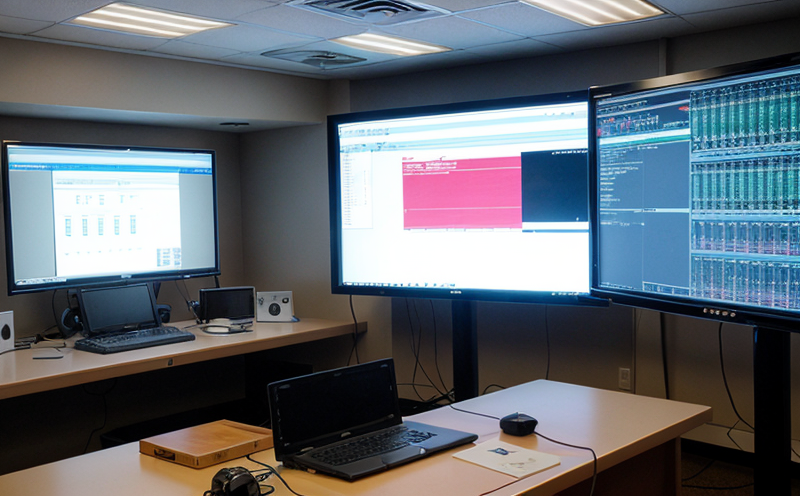EN 50121 EMC Testing of Signal Transmission Cables
The European standard EN 50121-4 specifies essential requirements and test procedures to ensure that signaling and control systems used in railway applications comply with electromagnetic compatibility (EMC) standards. This testing is critical for ensuring the proper functioning of signal transmission cables under all environmental conditions, thus enhancing reliability and safety on railways.
Signal transmission cables are crucial components in modern railway signaling and control systems. They ensure that data is transmitted accurately between various equipment such as trackside units, train-borne devices, and central control systems. However, these signals can be susceptible to electromagnetic interference (EMI) from both external sources (e.g., power lines, radio transmitters) and internal sources within the railway vehicle or signaling system.
EN 50121-4 specifies a series of tests aimed at ensuring that signal transmission cables perform their intended function without being affected by electromagnetic interference. These tests include:
- Electrostatic discharge (ESD) testing
- Radiated field immunity testing
- Transmitted signal strength immunity testing
- Broadband noise immunity testing
- High-frequency transients immunity testing
- Fast transient burst immunity testing
The tests are conducted in a controlled environment that simulates real-world conditions. For instance, during ESD testing, the signal transmission cable is subjected to high-voltage discharges to simulate lightning strikes or static electricity build-up within railway vehicles.
During radiated field immunity testing, the cable is exposed to electromagnetic fields generated by radio transmitters and other sources of interference. This ensures that the cable remains functional even in environments with high levels of electromagnetic noise.
The tests are performed on both single cables and bundled assemblies to ensure that they meet the required performance criteria under all conditions. The testing process involves careful preparation of the specimen, which includes selecting appropriate test samples based on the intended application of the signal transmission cable. Once prepared, the specimen is subjected to the specified test parameters using specialized instrumentation.
The results of these tests are used to determine whether the signal transmission cables meet the requirements set forth in EN 50121-4. Compliance with this standard ensures that railway signaling and control systems operate reliably under all conditions, enhancing safety and reducing the risk of system failures.
Non-compliance can lead to serious consequences, including malfunctions in critical safety systems, which could result in accidents or delays. Ensuring compliance through rigorous testing not only meets regulatory requirements but also contributes to a safer and more efficient railway network.
Why It Matters
The importance of EN 50121 EMC testing cannot be overstated, especially when considering the critical role that signal transmission cables play in ensuring the safe and reliable operation of railways. These cables are not just conduits for data; they are integral to the safety systems that prevent accidents and ensure timely operations.
EMC issues can lead to a variety of problems, including:
- Data corruption or loss
- Silent failures where equipment appears to be functioning normally but is actually not transmitting or receiving data correctly
- Increased susceptibility to external interference that could cause the system to malfunction
- Increased risk of electromagnetic compatibility issues with other railway systems, leading to potential conflicts and safety hazards
The reliability of signal transmission cables directly impacts the overall performance of railway signaling and control systems. Ensuring compliance with EN 50121-4 through rigorous testing helps to mitigate these risks by providing a robust and reliable system that can withstand the environmental challenges it faces.
By conducting EMC tests, railway operators can ensure that their equipment meets international standards, which is essential for interoperability across different systems. This not only enhances safety but also promotes smooth operations, reducing downtime and improving efficiency.
Why Choose This Test
- Rigorous Compliance Standards: EN 50121-4 provides a comprehensive framework for ensuring that signal transmission cables meet the highest international standards. By choosing this test, you ensure your equipment complies with these stringent requirements.
- Enhanced Reliability and Safety: The tests simulate real-world conditions, providing confidence in the performance of your signal transmission cables under various environmental and operational scenarios.
- Interoperability: Compliance ensures that your equipment can operate seamlessly with other systems, promoting a more integrated railway network.
- Regulatory Requirements: Many countries require compliance with EN 50121-4 for railways to ensure safety and reliability. Choosing this test helps you meet these regulatory demands.
- Improved Efficiency: By ensuring that your signal transmission cables perform optimally, you reduce the risk of system failures, which can lead to increased efficiency in railway operations.
- Expertise and Experience: Our laboratory is equipped with state-of-the-art facilities and experienced engineers who specialize in EMC testing. We ensure that every test is conducted to the highest standards, providing accurate and reliable results.
Selecting EN 50121-4 EMC testing for your signal transmission cables not only ensures regulatory compliance but also contributes to a safer, more efficient railway network.





